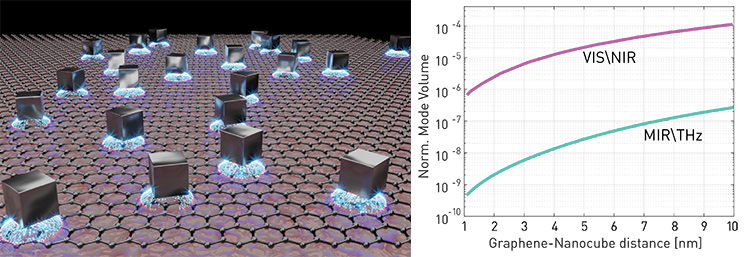 Nanoscale cavities for mid-IR confinement. Left: Graphene plasmon magnetic resonance (GPMR) system supporting an infrared graphene plasmon confined between a metal nanocube and a graphene sheet. Right: Normalized mode volume, Vmode/Vfree-space , for the GPMR system reaches one over a billion, and shows values four orders of magnitude smaller than the equivalent VIS/NIR system. [Matteo Ceccanti / chart from ref. 1]
Nanoscale cavities for mid-IR confinement. Left: Graphene plasmon magnetic resonance (GPMR) system supporting an infrared graphene plasmon confined between a metal nanocube and a graphene sheet. Right: Normalized mode volume, Vmode/Vfree-space , for the GPMR system reaches one over a billion, and shows values four orders of magnitude smaller than the equivalent VIS/NIR system. [Matteo Ceccanti / chart from ref. 1]
The mid-infrared and terahertz spectral ranges are crucial in areas such as molecular and biological sensing, food inspection, and the identification of hazardous materials, as many molecular resonances reside in this part of the spectrum. Detecting molecular signatures requires a significant field intensity, which can be achieved by tightly focusing the optical field to small dimensions, for example. This type of confinement, however, is still limited by the well-known diffraction limit. Recently, we extended the toolkit for detecting such signatures by taking advantage of the properties of graphene plasmons (GPs).1
GPs—electromagnetic field oscillations that couple with charge-carrier oscillations within the graphene sheet—can achieve extraordinary confinement of mid-infrared and terahertz light.2 Furthermore, if a metallic surface is brought near the graphene, it screens the existing GPs and enables even greater compression, to around 1/300 of their the free-space wavelength.3 Excitation of GPs is challenging, however, thus limiting their observation to micron-scale structures. This, in turn, has reduced their confinement capabilities by several orders of magnitude.
In our work, we have introduced a new approach to create nanoscale cavities for GPs.1 On top of the graphene sheet, we deposited randomly positioned silver cubes of about 75 nm in size. The graphene/nanocube system supports a confined GP mode in the form of a graphene plasmon magnetic resonance (GPMR). We found that, when the concentration of silver nanocubes is varied but their size held constant, only the amplitude of the response changes, while different sizes of nanocubes produce different spectral responses.
Thus, the properties of the individual nanocubes determine the optical response. Each nanocube acts as an individual cavity for GPs, compressing them into the nanometer-scale volume between the graphene and nanocube. With this approach, the GPs were compressed to a volume that is more than a billion times smaller than the free-space mode volume of the mid-infrared light.
Interestingly, we found that the excitation of the GPs was very efficient, despite the large mismatch between the micron-scale wavelength of the mid-infrared light and the nanometer-scale cubes. This is because the cavity acted as a GP nanoantenna, which interacts efficiently with infrared radiation, and the GPs were excited as a magnetic-resonance mode of the nanoantenna.
Our novel approach is capable of intensifying the mid-infrared radiation considerably, by compressing it to ultra-small mode volumes. We thus believe it may enable efficient detection of molecular materials and provide a promising sensing technology.
Researchers
Itai Epstein, Tel Aviv University, Tel Aviv, Israel, and ICFO–Institut de Ciències Fotòniques, Barcelona, Spain
Frank Koppens, ICFO and ICREA–Institució Catalana de Recerca i Estudis Avançats, Barcelona, Spain
References
1. I. Epstein et al. Science 368, 1219 (2020).
2. M. Jablan et al. Phys. Rev. B 80, 245435 (2009).
3. P. Alonso-González et al. Nat. Nanotech. 12, 31 (2017).
